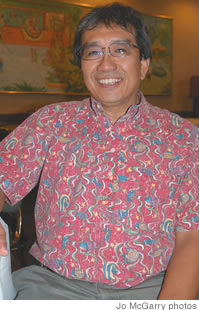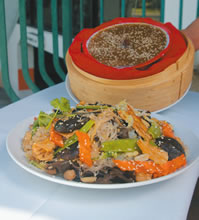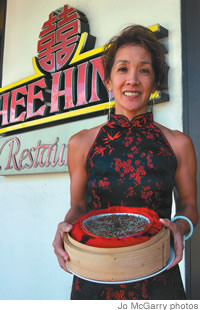Celebrating Chinese New Year at Hee Hing

Friday - January 23, 2009
|
 Del.icio.us |
Del.icio.us | 
|
To celebrate Chinese New Year this weekend, we headed over to one of the oldest family-run restaurants in Honolulu. At Hee Hing, James Lee has been part of the restaurant business for more than 46 years. He took some time to chat with us about his early working days, why dishes at Hee Hing are always changing, and what the Year of the Ox has in store.
Most people are familiar with Hee Hing; it’s something of a landmark Chinese restaurant in Honolulu. Is it the oldest?
I would think so; it’s certainly one of them. It’s always been in our family.
Do you have early memories of your parents working here and of spending time in the restaurant when you were young?
Well, I started working in the restaurant when I was quite young, so I do have a lot of memories of the earlier days.
Did you have an assigned job as a young boy?
I started when I was 6 years old as the cashier. There was a newspaper article written about me at that time:“the youngest cashier in Honolulu,“and people still remember that. Believe it or not they still come into the restaurant and say “are you the little kid that was behind the register?” That was 46 years ago, and they still remember.

|
So, naturally, you have generations of families coming here. Yes, of course. We help them celebrate everything from parties to banquets, weddings and graduations. We do a lot of funeral banquets, too. We help celebrate every family event and holiday. It’s one of the things I enjoy - customizing banquet menus so people can really enjoy our food.
A lot of family-run restaurants have problems trying to entice the next generation to take over the business. Are your kids interested in food?
Well, my son Charles is still in college - he graduates in May - but my nephews are here and working hard. I run the restaurant with my brother Henry, and his sons bring new ideas to us all the time. There’s a new version of dim sum, for example - a different type of manapua - that we hope to be launching soon. They bring fresh, new ideas and we think that’s really important for the continuation of the restaurant. Customers do want new things.
There’s a tendency, I think, with older restaurants to keep doing what they do well and not to change anything. You don’t subscribe to that theory, do you?
No. In this business, I think it’s particularly important to have new ideas.You have to keep things different to stop them from getting stale.
When my father started, we were right opposite Rainbow’s, and we were basically a very local Chinese restaurant - a chop suey kind of place. But we decided to bring in Hong Kong dim sum when we moved to this Kapahulu location and we tweaked the menu to make it more international in flavor.

|
How would you describe the food today at Hee Hing?
Our dishes are Hong Kong-based but with a local flavor. People here like more sauces, for example, than in Hong Kong - and bigger portions - so we adapt to the local palate, but we bring in new ideas and new dishes all the time.
How do you decide which new dishes will debut and which ones will go? There are certain staples that people expect to see on any Chinese menu.
Once a year I go with our chefs to Hong Kong and to Vancouver. There are lots of progressive Chinese chefs in Vancouver, where many restaurants opened in 1997. Hong Kong gives us an idea of what’s happening with the more regional dishes, and in Vancouver we get an idea of the cutting edge of Chinese food, the trends. We get inspiration from some of their ideas and we look at them and then bring back our own versions.
OK, so what’s new at Hee Hing, and what will always stay the same?
Some things, of course, will never change. The kau yuk will always stay on the menu. People want it the way they’ve always had it - and they want it red! And the shrimp Canton, which is an old-style dish, won’t change. For new dishes, there’s this braised short ribs that we’re doing. It’s a similar thing to the pork in kau yuk, but I found beef with a high enough fat content that gets softer and softer as you cook it. It goes well with taro and so far, local Chinese people really like the flavor . They realize it’s different, but they like it. They trust us!

|
This weekend you’ll have all the traditional foods for the new year. I know that your family has a very traditional - and very good - recipe for jai.
Yes, we make gau and jai for New Year’s. Gau is symbolic of unity. The mochiko rice with brown sugar is sticky and meant to keep the family together as one unit. Jai, of course, is also a highly symbolic dish with ingredients like ginko nuts and oysters and long rice that represent longevity and good fortune and health.
This past Year of the Rat wasn’t much fun. How do you see the coming year?
I think it was a hard year for everybody.
The Year of the Ox should be a very good year. I think that people are worried about what will happen and they have concerns, but I think it will be a better year than people think.
Hee Hing Chinese Restaurant 449 Kapahulu Ave. 735-5544
E-mail this story | Print this page | Comments (0) | Archive | RSS Comments (0) |
Most Recent Comment(s):












